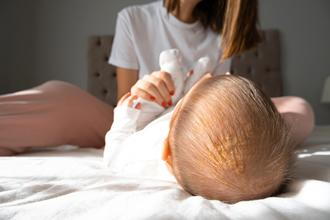
Noticing rough, scaly patches of skin on your newborn’s scalp? If so, this is a sign of cradle cap. This condition (also known as infantile seborrheic dermatitis) is fairly common in newborns and typically isn’t anything to worry about. It’s similar to dandruff for adults; however, while it might not be harmful or painful for your little one, you may be curious to know how to get rid of it. While it will go away on its own, there are things you can do from the comfort of your own home to treat symptoms of cradle cap.
First, is it actually cradle cap?
It’s important to be able to pinpoint the signs and symptoms of cradle crap. This condition most often occurs within the first 2-4 weeks of a baby’s life. This condition is characterized by oily, scaly, white or yellow patches that may crust over. While it might look unpleasant it isn’t painful and shouldn’t itch, but may be slightly red. You may also find these scaly patches on other parts of the body including the nose, ears and groin.
If the patches are itchy or painful, this could be a sign of another skin condition that will warrant seeing your pediatrician for an accurate diagnosis.
Should I seek treatment from a pediatrician?
Your baby’s cradle cap should go away on its own with a few weeks or months. You can care for cradle cap by simply using a mild shampoo and by shampooing your baby’s scalp every few days, which can help to remove scales. It’s important that you don’t scrub or become too aggressive with the scalp; however, if your child’s symptoms are severe or aren’t responding to home care, then it’s time to turn to a pediatrician who can prescribe a special, medicated cream or shampoo.
If you ever have concerns about your child’s health or any symptoms they may have, even minor ones, it’s important to bring it up with a qualified pediatrician that can address these concerns and also provide a fast diagnosis. No concern is too small when it comes to the health and wellbeing of your child.